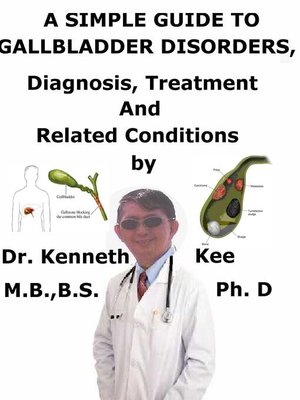A Simple Guide to Gallbladder Disorders, Diagnosis, Treatment and Related Conditions
ebook
By Kenneth Kee

Sign up to save your library
With an OverDrive account, you can save your favorite libraries for at-a-glance information about availability. Find out more about OverDrive accounts.
Find this title in Libby, the library reading app by OverDrive.



Search for a digital library with this title
Title found at these libraries:
| Library Name | Distance |
|---|---|
| Loading... |
This book describes Gallbladder Disorders, Diagnosis and Treatment and Related Disorders
They had me on the operating table all day. They looked into my stomach, my gall bladder, they examined everything inside of me. Know what they decided? No stones but I need glasses.
Joe E. Lewis
Gall indicate something bitter to endure such as bile or something disagreeable.
Asterix the Gall in the comic represents someone irritating to his enemies.
The gall bladder is a small sac on the underside of the liver that is used to store bile.
Bile is produced in the liver and kept in the gall bladder until it is needed to help the digestion of fat.
The most frequent reason for gallbladder disorder is gallstones.
Risk factors for Gallbladder Disorders
1. Forty: Over age 40 and increase in risk as one starts to age
2. Fat: Overweight
3. Female particularly those who have had children
4. Flatulent: gas in abdomen
5. Alcohol intake
5. Low stomach acid
6. Chronic Heartburn
7. Frequent use of Antacids
8. Rapid weight loss
9. High triglycerides, high LDL cholesterol, decreased HDL cholesterol,
10. Cholesterol-lowering drugs, immunosuppressive drugs
11. Antidepressants which slow down gallbladder contractions
12. Estrogen intake and birth control pills
13. Disorders such as chronic inflammatory bowel disorder, Crohn's disorder, Hemolytic anemias
14. Hypothyroidism
15. Diet high in saturated fats
16. Family history of gallbladder disorder
The most frequent symptoms are
1. Indigestion,
2. Gas, bloating,
3. Burping, belching
4. Constipation
5. Weight gain
It may progress to
6. Constant tenderness or discomfort under the rib cage on the right side.
7. Pain is worse after taking oily food
Diagnosis
To diagnose gallbladder disorder, the doctor will ask the patient about the medical history and perform an abdominal exam.
The doctor may conduct a special maneuver during the abdominal examination to find what is termed as "Murphy's sign."
If the patient feels significant pain taking a breath when the doctor palpates the area of the gallbladder, it suggests the patient may have gallbladder disorder.
An ultrasound can evaluate the gallbladder for the presence of gallstones, thickened walls, polyps, or masses.
A HIDA scan with the use of a harmless radioactive substance examines the duct system within the gallbladder and liver.
Endoscopic retrograde cholangiopancreatography (ERCP) is a very invasive but rather useful test because it can remove any blockage during this procedure
The treatment is dependent on the specific gallbladder disorder and may be:
1. Lifestyle Changes
2. Over-the-counter (OTC) pain medicines, such as ibuprofen
3. Prescription pain medicines, such as hydrocodone and morphine
4. Lithotripsy, a procedure that uses shock waves to break apart gallstones
Gallbladder surgery continues to be the most effective method for treating active gallbladder disorder.
The surgery can be done either by opening the abdomen with an incision or laparoscopically.
Inflammation causes the majority of gallbladder disorders due to irritation of the gallbladder walls, known as cholecystitis.
This inflammation is often caused by gallstones blocking the ducts that lead to the small intestine and inducing bile to build up producing cholangitis in the bile duct.
It may ultimately lead to empyema (pus formation) or necrosis (tissue destruction) or gangrene.
Gallbladder polyps and cancers are rare.
TABLE OF CONTENT







